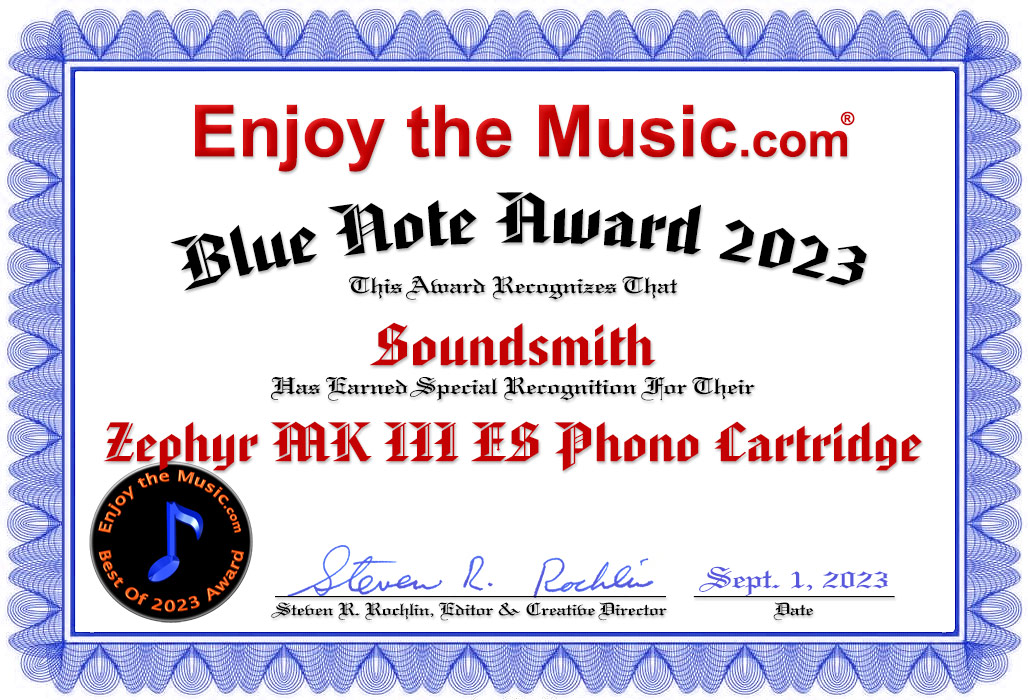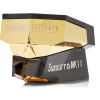Soundsmith Strain Gauge SG-200 phono cartridge system

"This thing stopped and started faster than any cartridge I've ever heard. The speed and precision of its instrumental attack set new standards for phono cartridges, in my experience, as did its overall transparency and its rhythm'n'pace. In the best sense, it made my Wilson Audio Specialties MAXX 3 speakers sound like electrostatics, but with full bass extension and dynamic capabilities."
- Michael Fremer, Stereophile
By Michael Fremer • Posted: Mar 22, 2011
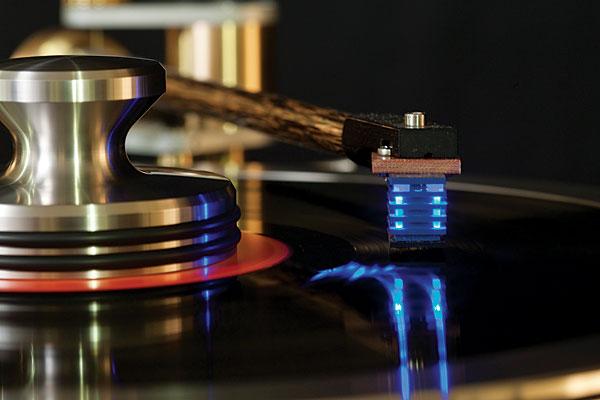
[ed- Information correct at publishing date / prices and specs are no longer current!]
Strain-gauge phono cartridges are rarely made and seldom heard; for most vinyl fans, they are more myth than fact. Panasonic once made one, as did Sao Win, but those were decades ago. I've heard about those two models for years but have never seen, much less heard one.
As if he's not got enough to do building his extensive lines of moving-iron cartridges, preamplifiers, amplifiers, and speakers, Soundsmith's Peter Ledermann also makes a full line of strain-gauge cartridge systems available with a choice of six user-replaceable stylus profiles. I believe the Soundsmith is the only strain-gauge cartridge currently made anywhere in the world. Ledermann says it takes him a full day to build one.
I've often seen—and sometimes even heard—Soundsmith's blue-lit strain-gauge models at Consumer Electronics Shows and various consumer audio events, but only in entirely unfamiliar systems. Because of the impossibility of making any kind of judgment of their sound under such conditions, I've pretty much ignored what I heard in those rooms, though the reactions of other listeners have ranged wildly, from wide-mouthed "Wow!"s to scrunched-face grimaces of distaste. All it did was intensify my curiosity to hear one at home in my own system.
However, because a strain-gauge model requires an active power source, the cartridge must be used with an outboard preamplifier and power supply. Until very recently, Soundsmith incorporated its strain-gauge circuitry within a wide range of standalone full-function preamplifiers: if you wanted to own or review one of their Strain Gauge models, you had to replace your preamplifier with Soundsmith's—not only an unattractive proposition for anyone already happy with his or her preamp, but the simultaneous swapping out of two audio components makes for an unsatisfactory review context: how do you know which new component is doing what to the sound?
Soundsmith now offers its Strain Gauge cartridge with a reasonably priced dedicated interface that simply and only plugs into any preamplifier's line-level input. Ledermann says that this circuit is identical to what's in the full-featured preamps. The long-promised SG-200 system, which Soundsmith calls its "entry-level" model, recently arrived here, and I immediately installed it in a Graham Engineering Phantom II tonearm.
What is a strain-gauge cartridge, anyway?
In a standard phono cartridge, a mass—a magnet or a coil—must be moved to generate a voltage. The mass must be supported by an elastomer suspension that acts as a kind of shock absorber for the mass, which is attached to a cantilever-stylus assembly. When that assembly moves, displaced by the modulations in the record groove, it in turn moves the coil or magnet. A certain amount of that transferred energy is transformed into heat in the suspension and is thus lost. The coil-magnet system turns what's left into a tiny amount of voltage.
A strain gauge is a tiny piece of silicon or other material whose resistance to a current flow supplied to it changes as it expands and contracts. It's typically used in devices that measure pressure. A stereo strain-gauge phono cartridge uses two of these ultradelicate devices, which are flexed by the cantilever pressing on the carrier holding them. The design of the Strain Gauge carrier is proprietary to Soundsmith, and Ledermann didn't want to tell me much about it. The interface that supplies current to the cartridge includes a low-noise preamplifier that increases the cartridge's tiny modulated voltage to line level.
The biggest advantage of such a system over a standard voltage-generating system such as a moving-magnet or a moving-coil is, of course, that virtually no mass need be moved in order to produce a modulated voltage, which means that almost no energy is lost in overcoming the inertia of a magnet or coil. The stylus-cantilever system can therefore respond far more quickly, and so is able to more accurately trace the groove walls. Theoretically.
Displacement-, not velocity-based performance
I haven't mentioned RIAA equalization so far because, with this system, none is needed.
RIAA equalization is applied when a lacquer is cut, attenuating the low frequencies and boosting the high frequencies. When the resulting LP is played, a complementary RIAA filter in the preamplifier attenuates the highs, dropping noise in this region well below audibility while restoring flat HF response. Attenuating the lows during cutting limits the lateral groove displacement, thus permitting a tighter groove spiral, which means that more music can be packed onto each LP side. When the record is played, the preamp's RIAA equalizer restores a flat bass response to the sound by boosting the lows.
Magnet-based cartridges, MM or MC, are devices that are sensitive to velocity, which is measured as distance over time; their electrical output is directly proportional to the stylus's speed as it's moved back and forth by the zigs and zags in the groove. By contrast, strain-gauge and piezo-electric (crystal or ceramic) cartridges are sensitive to displacement, without regard to time. Move the stylus in such a system the same distance, whether very slowly or very quickly, and the electrical output will be the same.
Magnet-based cartridges are very sensitive to how quickly or slowly the generator system moves. Moving such a system slowly produces far less output than moving it quickly. Think of your bicycle's generator: the faster you pedal, the brighter the headlight. So imagine an LP cut "flat," with no equalization applied, and using a magnetic cutter head—another velocity-sensitive device. Lower frequencies would move the cutting stylus far more than higher frequencies, which would create serious problems when the record was played by a displacement-sensitive strain-gauge cartridge. However, RIAA equalization is applied, greatly cutting LF and slightly boosting HF lateral displacement.
So consider a 20Hz–20kHz test-record signal that's been recorded at the same amplitude for all frequencies, but using RIAA. Since we've boosted the lateral displacement of the highs and cut the lateral displacement of the lows, we get nearly equal groove displacement at all frequencies. Thus, a displacement-sensitive device like a strain-gauge cartridge creates an automatically flat response with no RIAA equalization applied to the output. Instead of a complex filter network in the line, all that's needed is a simple, low-distortion preamplifier stage.
In sum, a strain-gauge cartridge is a low-mass, low-inertia mechanical system that can accurately trace a groove with blazing speed and requires no RIAA equalization—vs a higher-mass, higher-inertia system that can't track or trace as quickly, and that requires a complex RIAA equalization circuit.
In reality, there are subtle changes in equalization in the RIAA curve that need to be compensated for, and Soundsmith's preamplifier does that—but it's still much simpler than a full-blown RIAA circuit, and the resulting frequency range is claimed to be an astonishing DC–70kHz (though the circuit also includes a staggered low filter for minimal impact on the signal)
Soundsmith Strain Gauge SG-200
Its two bright-blue tubular LEDs, which run vertically through the metal body's horizontal slats, give the Soundsmith Strain Gauge cartridge a unique look. Unlike most cartridges, it features controls for adjusting vertical tracking angle (VTA) by ±3°, as well as azimuth, though these are to be used only if your tonearm doesn't offer them.
The cartridge's mass (10gm) and compliance are suitable for any modern-day tonearm of medium to high mass. The compliance is unique in being designed to vary more with vertical tracking force (VTF) than is usual: from 16µm/millinewtons at 1.5gm to 10µm/mN at 2.5gm. This allows for a bit of "tuning," according to Peter Ledermann, but even within that range, it's a low- to medium-compliance design.
When you order your Strain Gauge cartridge, it comes standard with the SGS-5 nude line contact/Ruby cantilever and power supply for $5499.95. However, Ledermann says that most buyers opt for the SGS-6, an "Optimized Contour" nude line-contact stylus with a ruby cantilever, which adds $100 to the system price.
Soundsmith offers six user-replaceable styli:
SGS-1: bonded Shibata, aluminum cantilever ($149.95)
SGS-2: nude elliptical, aluminum cantilever ($199.95)
SGS-3: 1-mil radius, conical, aluminum cantilever ($199.95)
SGS-4: 3-mil radius, conical, 78rpm, aluminum cantilever ($199.95)
SGS-5: nude line contact, ruby cantilever ($399.95)
SGS-6: nude "Optimized Contour" line contact, ruby cantilever ($499.95)
Soundsmith strongly recommends factory installation of your choice of stylus, to ensure perfect alignment and top performance. Removing and reinstalling the same stylus won't change its performance, but switching to another stylus at home requires resetting azimuth, VTA, and stylus rake angle (SRA), all of which are critical for extracting maximum performance from this system (or from any cartridge, really)—but particularly with the two most severe stylus profiles. When ordering additional or replacement styli, free factory custom fitting is recommended for top performance.
The review sample of the SG-200 Strain Gauge came fitted with the SGS-5 and SGS-6 styli.
Setup and use
Hookup follows the standard system of four color-coded pins, although, as the instructions point out, since the cartridge's strain-gauge elements have no polarity and are purely resistive devices, you can reverse polarity with no change in performance. But why would you?
The SG-200 power supply is based on a pair of 24V DC wall warts that I didn't plug in until I'd installed the Strain Gauge cartridge in the Graham Phantom II arm and made all connections. When everything was plugged in, a flip of the power switch lit up green and red LEDs on the interface that indicated that both negative and positive supplies were active.
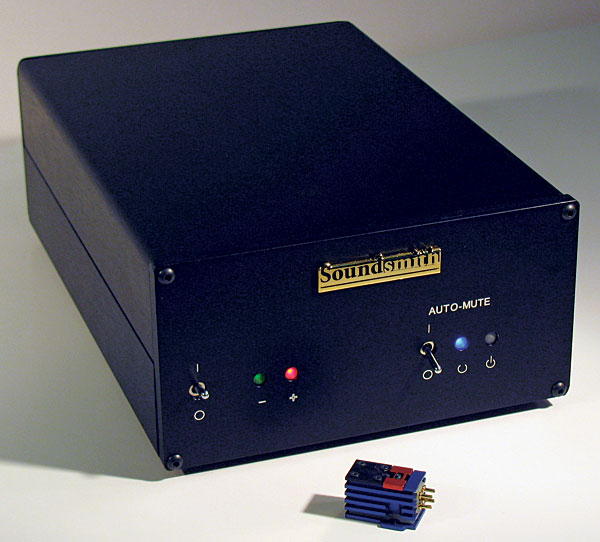
Leave the Soundsmith preamp's Auto Mute switch in the down position on plug-in, and the cartridge's two blue LEDs light and your excitement rises. If you put the Mute switch in the up position, the yellow Mute LED glows until the preamp senses a signal from the cartridge, at which point the blue Unmute LED will light. This prevents loud pops, should you accidentally drop the stylus onto the record. A second muting system senses a faulty connection between the cartridge and preamp. It also lets you unplug the tonearm or headshell without turning down the volume.
VTA and SRA are critical with both supplied styli, so I used a digital USB microscope to achieve 92° SRA. This put the cartridge's body up in the back (Soundsmith's recommended orientation is parallel to the record surface).
You could use the Musical Surroundings Fozgometer azimuth-alignment device and The Ultimate Analogue Test LP (LP, Analogue Productions AAPT 1) to precisely set azimuth, but I'm now using a digital oscilloscope that's theoretically more accurate. No more guessing. If you're spending this kind of money on a cartridge, I suggest you either get these devices and learn how to use them (I'll cover the digital oscilloscope in an upcoming column), or find someone who has.
The Strain Gauge's recommended range of VTF is 1.7–1.9gm. Though the cartridge can theoretically track as low as 1gm and as high as 2.5gm, neither setting is recommended. I went with 1.8gm.
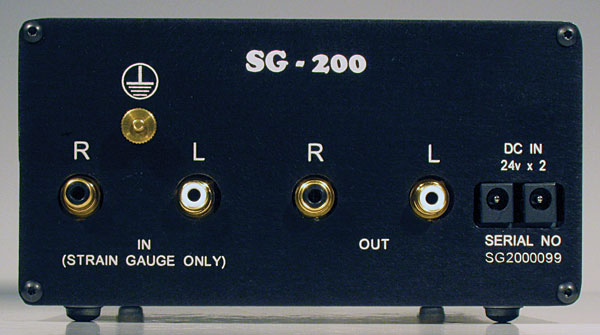
And now for something completely different
Remember the first time you heard a pure electrostatic speaker, and how fast, open, detailed, and free of gross cabinet colorations it sounded? That was pretty much my experience of listening to the Soundsmith Strain Gauge SG-200 for the first time, though like electrostats, the Strain Gauge had a particular sonic quality that some will love and others won't—and, of course, it will flatter some records and render others unpleasant.
As quoted on Soundsmith's website, someone from the Mid-Atlantic Audiophile Group said that the Strain Gauge "leapfrogs the finest moving-coil cartridge." Well, it certainly did that in somerespects, and convincingly, too—just as electrostats leapfrog moving-coil speakers—in some ways. The sound the Strain Gauge produced was, like that of every other cartridge I've ever heard, distinctive. Some will fall in love, others will run like hell—and from the same qualities.
Well, count me among the wide-eyed—at least when it came to the Soundsmith system's incredibly clean and fast top-to-bottom transient attack, its spectacular transparency, its taut, deep bottom end, and its airy top. This thing stopped and started faster than any cartridge I've ever heard. The speed and precision of its instrumental attack set new standards for phono cartridges, in my experience, as did its overall transparency and its rhythm'n'pace. In the best sense, it made my Wilson Audio Specialties MAXX 3 speakers sound like electrostatics, but with full bass extension and dynamic capabilities.
With either of its two supplied styli, the SG-200 traced the groove as well as any cartridge I've used and better than most, particularly in its tracking of HF transients and vocal sibilants. If there were any lumps or bumps in its frequency response, they were difficult to hear, though after a while I think I found a midband trough. Still, the SG-200's overall tonal neutrality was unquestionably superior to all but a few of the best cartridges I've heard through the best phono preamps. Its background blackness never failed to amaze me, and its generously wide, deep, tall soundstage indicated unusually low levels of crosstalk (which I confirmed by measurements). But none of that means that everyone will enthuse about how it actuallysounded.
With the top-of-the-line SGS-6 stylus in place, I auditioned a recent remastering of Paul McCartney and Wings' Band on the Run (Hear Music/Concord Music Group UMG 8 88072 32566 1). The percussion in "Bluebird" was positively astonishing: razor-sharp, as in "utterly natural," without being brittle or etched. The acoustic guitars, tom-toms, and bass lines in "Mrs. Vandebilt" were so cleanly and precisely rendered, so naturally fast and taut, that my ear/brain couldn't help but be drawn in and transfixed by the novelty of the sound compared to that of any standard cartridge.
That stop-and-start ability, that freedom from overhang that audiophiles often confuse with "warmth," are leapfroggings in performance over more usual cartridge designs—yet the SG-200's delivery was so fast and clean that there was little time for harmonic development to unfold before it was off to the next aural event. So while the attack was extraordinary, the sustain was somewhat stingy. The SG-200 could sound somewhat cool and lacking in physicality, and while its top was crystalline and airy and its bottom tight, deep, and well textured, the mids were less than fully fleshed out, making the overall sound somewhat cool and slightly recessed.
When I played the same copy of Band on the Run with the Ortofon A90 cartridge, I got a totally different but equally valid performance that, in its own way, leapfrogged the Strain Gauge: There was more weight and, especially, texture in the bottom end, more follow-through of the instrumental harmonic structure, more "skin" in the toms, more flesh in the voices, and, in general, more roundness and body to further flesh out the three-dimensional picture. But the magnetic Ortofon does sound slower, less well defined, and, particularly, somewhat less transparent and immediate than the SG-200.
Playing the essential 45rpm reissue of Nat King Cole's Love Is the Thing (LP, Capitol/Analogue Productions SW-824) with the SG-200, I was quickly made aware of the vocal microphone's rising high end. The bow scrapes on the strings get greater emphasis, the sheen and woody resonance somewhat less. Cole's chest cavity plays second fiddle to his vocal cords and mouth. Through the Ortofon A90, the emphasis was reversed. Which you will prefer will depend on your system and taste.
But consider that for $5600, the SG-200 Strain Gauge is complete. The $4200 A90 still needs a phono preamp, and in this case I used the $28,000 Ypsilon VPS-100, along with a few other top-shelf tubed and solid-state preamps—and the two systems were on a reasonably level playing field in terms of macrodynamic slam, HF extension, and resolution of detail. With a good magnetic cartridge, however, you can alter the flavor as necessary by changing the phono preamp. That's not the case with the Strain Gauge, which is what it is.
The differences between a great MC system and the Strain Gauge can make evaluating different pressings of the same album difficult. Right now I'm listening to the two new Rolling Stones boxes. Tattoo You sounds positively muffled and dynamically dead through the Ortofon A90, but through the Strain Gauge it sounds reasonably alive on top, though still dynamically dead. The life has been compressed out of the new records, though not so the ABKCO box of the earlier Decca/London-era Stones.
I suspect that the Strain Gauge cartridge's displacement-based operating system was in some way emphasizing the RIAA HF boost. It's not the same as the resonant peak found in the sounds of most MC cartridges, because it's not an obtrusive brightness or a detail-obscuring ringing. Instead, this rising top end was an addictive, finely focused light that, with the right recordings, reproduced with astonishing clarity and definition tambourines, cymbals, and electric guitars, particularly Fender Stratocasters.
This character had me pulling out records like the Byrds' chimey first album, Mr. Tambourine Man (LP, Columbia). Roger McGuinn's 12-string Rickenbacker and the constantly rattling tambourine were reproduced with greater clarity, authority, and purity than I've ever heard, yet neither sounded too bright or edgy. On the other hand, McGuinn's voice was less coherent; its timbre was slightly off, making his very well-known voice less recognizable. But if you try to predict how familiar recordings will sound with the Strain Gauge, you'll probably be wrong much of the time. As with the Decca cartridges, I found that how a particular record, or a particular instrument on that record, would sound through the Strain Gauge was not at all predictable.
An example: I predicted that Vladimir Ashkenazy's piano, on his set of the Beethoven concertos with Georg Solti and the Chicago Symphony (LPs, Decca SXLG-6594-7), which I use as a reference, would sound tinkly through the SG-200. That's not what happened. Instead, the first thing I noticed was how the Soundsmith's astonishing stop-on-a-dime speed laid bare Ashkenazy's pedal work. When he took his foot off and the damper hit the strings, the stopping of the sound was head-through-the-windshield fast as I've never before heard it. The hammer attack was equally precise, but the overall piano sound was somewhat recessed and almost drab in the midrange, as if the sustain was being absorbed by a sponge.
There's a banjo part in Virgil Thomson's The Plow that Broke the Plains, performed by Leopold Stokowski and the Symphony of the Air (LP, Vanguard VSD 2095). Through the Strain Gauge, it had a startlingly distinctive metallic ring that some would think realistic but others might find hyped-up and "hi-fi"–ish. It was in that region of the spectrum—cymbals, banjo, plucked guitar strings, etc.—where the Strain Gauge's most distinctive personality trait manifested itself.
After spending a few weeks listening to the extra-cost SGS-6 "Optimized Contour" line-contact stylus, I switched to the less severely profiled but equally setup-critical SGS-5 line-contact stylus. While everything I'd heard previously remained, the emphasis on instrumental attacks was now somewhat diminished. That helped to produce a less hyper, more unified sound that I felt was less hi-fi and more natural, though the mids were still less than generous and somewhat recessed relative to the octaves above and below, and the HF emphasis remained. In my system, I preferred the standard SGS-5 to the SGS-6.
Conclusions
Adherents of strain-gauge cartridges warned me that, once I'd heard one in my system, I would become hopelessly addicted to it. After spending a few months listening to the Soundsmith Strain Gauge SG-200, and despite the obvious need to pick apart its sonic character for this review, I've found that they were right. The SG-200 is a unique game-changing product.
Switching to Soundsmith's Strain Gauge SG-200 from a standard magnetic cartridge, MC or MM, produced a seismic sonic shift similar to switching between speakers based on different technologies. But it's a far more practical way to add a transformative component to an audio system and to swap it in and out with ease, particularly if your analog front-end has two tonearms or your arm has detachable headshells—or, like the Graham Phantom II arm, interchangeable wands. The SG-200 is a perspective-changer, that's for sure, and not because it adds gross colorations—though with that apparently rising high end, it definitely has a unique sonic character. Don't expect unrelenting brightness, because it didn't consistently sound like that. That particular quality seemed to be record-dependent, and not predictably so, for reasons perhaps Peter Ledermann can explain.
If I could afford it right now, I'd buy the SG-200 in a Peekskill minute. It's as addicting as its proponents say, and I'm going to miss it.
Specifications
Description: Strain-gauge phono cartridge with interchangeable styli (6 choices) and dedicated preamplifier and power supply (two 24V DC wall warts, no specifications provided). Styli supplied (both with ruby cantilever): SGS-5 nude line contact (standard, $399.95 if purchased separately), SGS-6 "Contour Optimized" nude line-contact ($499.95 if purchased separately). Recommended vertical tracking force (VTF): 1.7–1.9gm. Compliance: low–medium, depends on VTF, 10–16µm/mN. Frequency range: DC–70kHz. Effective tip mass: 0.30mg, SG-10; 0.32mg, SG-5. Channel separation: >25dB at 1kHz. Channel balance: <1dB. Recommended load resistance: not applicable. Recommended load capacitance: not applicable.
Dimensions: Cartridge weight: 10gm. Preamplifier/power supply: 6" (150mm) W by 3" (80mm) H by 8" (205mm) D. Weight: 2 lbs (0.9kg).
Serial Number Of Unit Reviewed: SG2000131.
Price: $5499.95 with SGS-5 stylus; add $100 for SGS-6. Approximate number of dealers: 18; also sold direct. Warranty: "All cartridges are warranted against defect in workmanship for a period of not less than one year."
Manufacturer: The Soundsmith, 8 John Walsh Blvd., Suite 417, Peekskill, NY 10566. Tel: (800) 942-8009, (914) 739-2885. Fax: (914) 739-5204
Soundsmith Strain Gauge SG-200 phono cartridge system Associated Equipment
Associated Equipment
Analog Sources: Continuum Audio Labs Caliburn, Cobra, Castellon turntable, tonearm, stand;Graham Engineering Phantom II tonearm, Ortofon A90 cartridge.
Digital Sources: Playback Designs MPS-5 SACD/CD player–DAC, BPT-modified Alesis Masterlink hard-disk recorder, Benchmark ADC1 A/D converter, Sooloos music server, Pure Music software.
Preamplification: Ypsilon VPS-100, Allnic H-3000, Einstein Turntable's Choice phono preamplifiers; darTZeel NHB-18NS preamplifier.
Power Amplifier: Musical Fidelity Titan.
Loudspeakers: Wilson Audio Specialties MAXX 3.
Cables: Phono: Hovland/Graham Engineering MG2 Music Groove. Interconnect: TARA Labs Zero, Stealth Sakra, ZenSati. Speaker: TARA Labs Omega Gold, ZenSati. AC: TARA Labs The One Cobalt AC, Shunyata Research King Cobra Helix CX, Isoclean 1000.
Accessories: Shunyata Research V-Ray II Reference, Silver Circle Audio Pure Power One 5.0, TARA Labs Power Screen power conditioners; Oyaide AC wall box & receptacles; Finite Elemente Pagode, HRS SXR stands; Symposium Rollerblocks; ASC Tube Traps, RPG BAD & Abffusor panels; Audiodharma Cable Cooker; Furutech DeMag & deStat LP treatments; VPI HW-17F, Loricraft PRC4 Deluxe record-cleaning machines.—Michael Fremer


